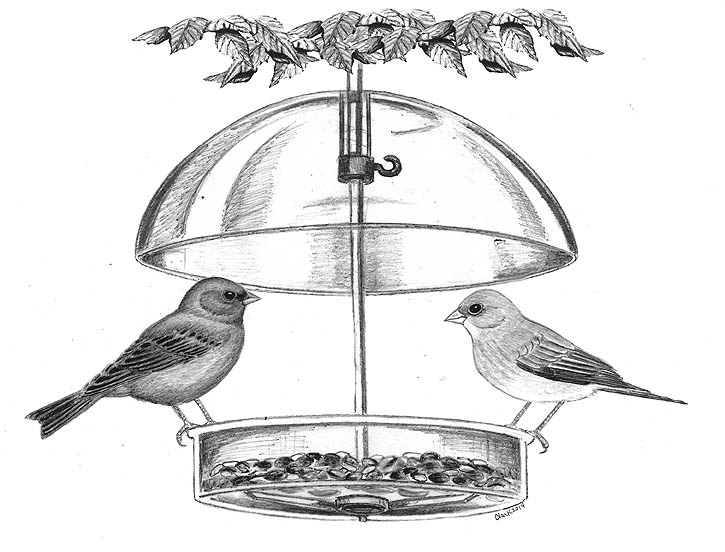
Dear Bird Folks,
A male and female Indigo Bunting have just landed on my feeder. Is there a particular food I should give them? Will they be around all summer?
– Amy, Orleans, MA
You win, Amy,
As I was finishing up this week’s column, I started getting calls, emails and text messages about Indigo Buntings. It wasn’t just one or two, either. There was a steady stream of them. I almost began answering the phone: “Hello, Indigo Bunting Hotline.” Ordinarily, buntings would be a good topic, but I had already written my column for the week and didn’t want to start all over. That’s when I received your note and decided to stop the presses, and address this Indigo Bunting phenomenon. I just hated deleting my original column. What was that column about, you ask? It was about a top-secret invention that would keep squirrels out of our yards…forever. Oh, well. I guess we’ll never know.
Looking and acting like a small finch or a sparrow, Indigo Buntings are actually more closely related to cardinals, very tiny cardinals. And like cardinal couples, there is an obvious difference between the two sexes. However, indigo pairs take the differences to an extreme. As the name suggests, these birds are brilliant indigo blue. But this rich coloring only applies to adult males in breeding plumage. Conversely, the female indigos could not be any duller. A pair of khaki pants has more pizzazz than these ladies do. I would bet that most folks wouldn’t even notice a female Indigo Bunting, even if it were on their feeder. So, good for you, Amy; you had no trouble recognizing the female bunting. You must be a good birder (either that or you know a lot about khaki pants).
Like hummingbirds and orioles, Indigo Buntings have just returned to our area from Central America. But unlike hummers and orioles, once migration is over Indigo Buntings don’t seem to spend a lot of time on our feeders. Every May I hear reports of bunting sightings (usually only a few, not the trillions I’ve received so far this year). Then things quiet down and no one mentions them again. Where do they go? Are they just passing through, like feathered carpetbaggers? Yes, many buntings only stop on Cape Cod during their migration, but some of them actually breed here. The problem is, buntings don’t seem to breed in our backyards. Where do they breed? That’s a good question; too bad I don’t know the answer. I can tell you where the nearest Bald Eagle’s nest is (Brewster town dump), but locating a bunting’s nest is far more challenging. Indigo Buntings like to keep their nests well hidden, and the cryptic brown females don’t make things any easier.
As with a lot of birds we have been discussing lately, Indigo Buntings favor transitional habitats. Meadowlarks, for example, require open fields and woodpeckers love big trees. Buntings are attracted to the more scrubby areas, such as overgrown fields and orchards. One of their favorite breeding locations is underneath power lines, where the trees tend to be small and scrawny. Buntings love this type of habitat (if we could only keep the power company knuckleheads from spraying it with toxic herbicides).
Typically, the female does all of the nest construction. The reasons for this aren’t clear, but having the male stay out of her way likely saves the couple from lots of bickering (and believe me, I know). That doesn’t mean the male is a slacker. While the female is building and incubating, he is close by, singing from the top of the tallest tree. In fact, the best way to find Indigo Buntings during the breeding season is to listen for the male’s incessant singing. If you learn his song, you should be able to find the bird. Unfortunately, I can’t easily describe the song for you on paper. I tell people that it sounds finch-ish. After that, you’re on your own.
As to what kind of food you can offer Indigo Buntings: Based solely on what I’ve seen, it seems their favorite feeder food is white millet. Their second choice appears to be thistle (niger), followed by sunflower. But before you run out and start loading your feeders with white millet, keep in mind that it’s unlikely the buntings we see in May will still be coming to our feeders in June. Once the babies start hatching, the adults focus on gathering insects and tend to forget all about feeders for a while. I hate that abut them.
I know it’s a long way off right now, but one of the best places to look for Indigo Buntings each fall is in local community gardens. Old flowers and weed seeds attract lots of migrating birds. Why don’t the buntings stop at our feeders in the fall? Perhaps they do (or don’t), but come fall they are much less noticeable. After the breeding season, the birds go through a complete molt. At that time of year even the males are “indigo” in name only. They’ve become more brown than blue and could be easily overlooked, like a pair of khaki pants.
I wouldn’t be in a hurry to buy any special seeds for your buntings, Amy. Whatever you are offering them right now is clearly working, but don’t expect them to stay in your yard much longer. If you want to see your buntings in June or July, you’ll have to take a walk along the power lines. Just keep a HAZMAT suit handy.